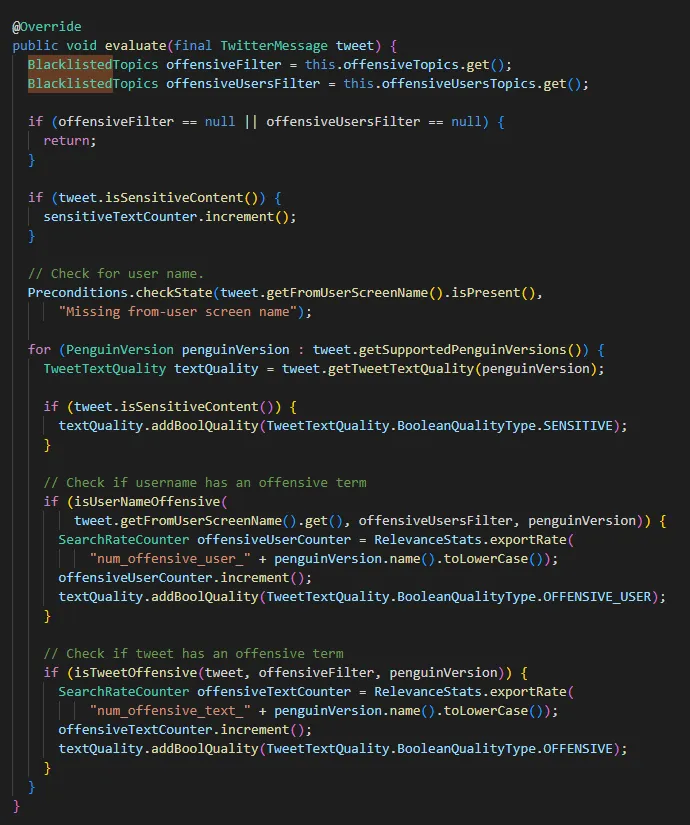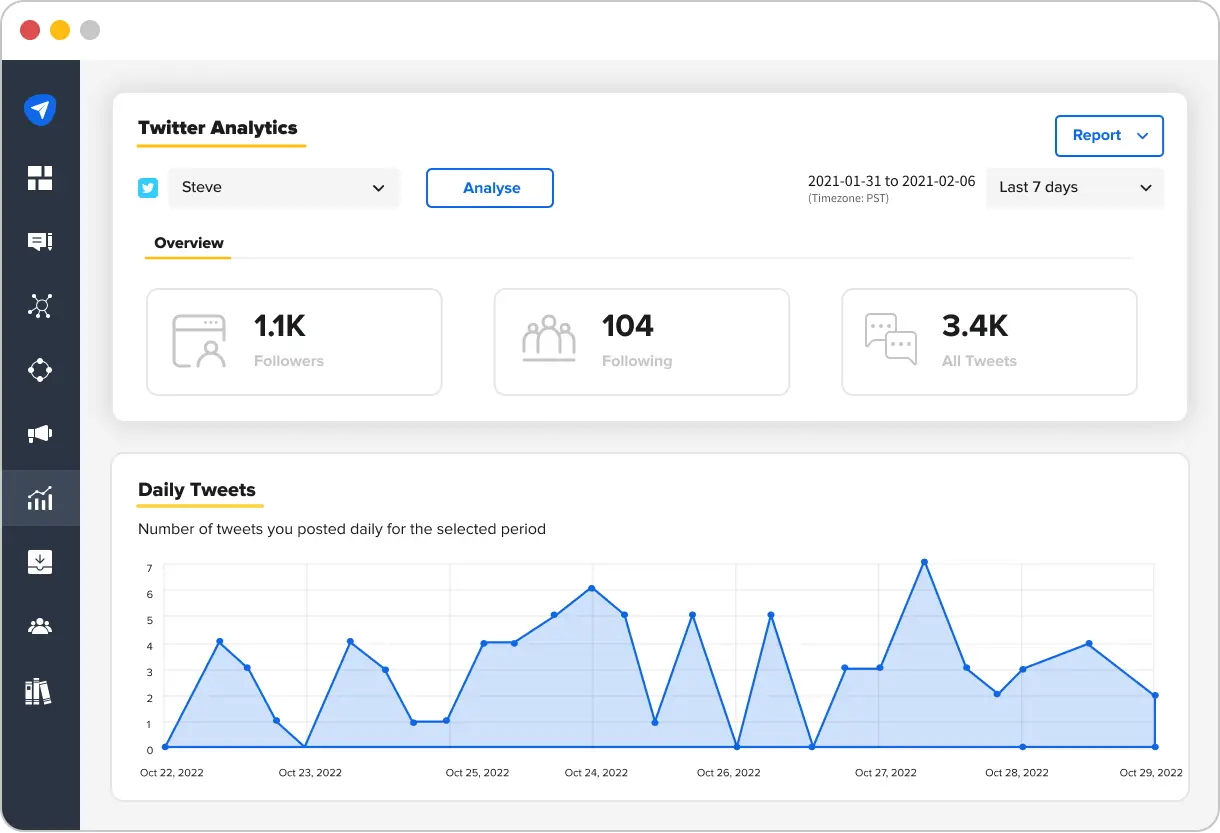How The Twitter Algorithm Works & Tips to Beat It in 2023
- June 14, 2023
- Knowledge Base
- 0 Comments

Are you looking to enhance engagement and generate leads via Twitter? Or perhaps you’re finding it challenging to navigate the Twitter algorithm to bolster your brand awareness?
Regardless of your goal, understanding the Twitter algorithm is a crucial first step.
So, what exactly is the Twitter algorithm?
The Twitter algorithm is a complex system that determines the ranking of tweets on your timeline. The algorithm ranks content based on several factors, including personal interest, location, recency, and virality.
This blog post will dive into these factors and explain how they influence the content ranking on your feed.
Moreover, we’ll provide actionable marketing strategies to help you outsmart the Twitter algorithm.
Based on our research, we’ve identified eight key Twitter metrics that you should prioritize in your marketing campaigns.
8 Top Twitter Metrics to Prioritize
Twitter has provided some insights into ranking signals. Based on that, the top eight metrics influencing users’ timelines:


However, understanding these metrics and creating Twitter campaigns around them is only the beginning. To truly, succeed, you must grasp how the Twitter algorithm works and recognize its core ranking signals that denote quality.
How Does the Twitter Algorithm Work in 2023?
The Twitter algorithm is designed to personalize your feed and deliver content relevant to your interactions on the platform. Previously a closely guarded secret, Twitter has since released its algorithm source code on GitHub.
This code revelation provides insights into the key metrics considered for the platform’s timeline and search result section. Along with sharing the source code, Twitter also published a blog post detailing its recommendation algorithm.
Decoding the Twitter Recommendation Algorithm
The Twitter recommendation algorithm plays a crucial role in curating tweets for the platform’s explore, search, and ads sections. According to Twitter, the recommendation pipeline consists of three main stages: candidate sourcing, candidate ranking, and using heuristics and filters for tweets the user doesn’t engage with.
The “For You” timeline is personalized for each user through Twitter’s service known as the Home Mixer. Built on Twitter’s Scala framework, the Product Mixer, this service sources, ranks, and processes tweets to populate individual user feeds.


Understanding the Recommendation Pipeline
Now, let’s dive in to understand how the three stages in the recommendation pipeline work:
1. Candidate Sourcing
In the candidate sourcing stage, Twitter gathers the best tweets from various recommendation sources. This includes both In-Network sources (accounts you follow) and Out-of-Network sources (accounts you don’t follow). The aim is to display a balanced mix of these tweets on your “For You” timeline.
The In-Network source compiles recent tweets from the accounts you follow. These tweets are ranked based on a logistic regression model that predicts your likelihood of engaging with the tweet’s author.
Sourcing Out-of-Network tweets is more complex as it involves identifying relevant tweets from millions of accounts you don’t follow. Twitter uses two approaches for this: the social graph and the embedding space approach.
The social graph filters tweets based on the engagement of accounts you follow and those with similar interests. It considers what tweets the people you follow have engaged with and who has liked the tweets you liked.
The embedding space approach finds tweets and users similar to your interests. Twitter’s SimClusters, an embedding space, groups users into communities or topic categories led by influential users. If a tweet gains popularity within a community, it has a chance to appear on the “For You” timeline of users within that community.
Here are some of the biggest communities identified and created by Twitter.


2. Ranking
Under this stage, all tweets, regardless of their source, are ranked based on Twitter’s machine learning model. From the initial ~1500 sourced from In-Network and Out-of-Network, Twitter ranks them for relevance.
At this stage, all tweets are considered equally. However, Twitter hasn’t entirely revealed its ranking mechanism, and here is how they quoted it to maintain its fair share of transparency.


3. Application of Heuristics, Filters, and Product Features
Following the ranking process, the Twitter algorithm applies heuristics, filters, and product features to refine the tweet selection. This excludes viewed tweets, tweets from blocked accounts, and tweets containing NSFW content. Twitter employs several features to maintain a diverse and balanced feed:
a. Author Diversity: Ensures that consecutive tweets from a single author are not displayed.
b. Visibility Filtering: Filters tweets according to your preferences.
c. Content Balance: Strives to display a balanced mix of In-Network and Out-of-Network tweets.
d. Social Proof: Excludes Out-of-Network tweets that haven’t engaged any user you follow.
e. Conversations: Provides context to tweet replies by threading them to the original tweet.
f. Blacklisted Topics: The Twitter algorithm code highlights this element, but it doesn’t reveal the specific topics included. It’s crucial to be mindful of the topics you post about and avoid spamming.


The three stages in the recommendation pipeline work together to optimize the user experience on the “For You” timeline. However, to beat the Twitter algorithm, you need to have a deeper understanding of the Twitter algorithm ranking signals.
So, let us get to know them.
Twitter Algorithm Ranking Signals
Over the years, the Twitter algorithm has undergone numerous changes. While some of these changes have been publicly disclosed, others were revealed when Elon Musk unveiled the algorithm’s code. Despite these revelations, several ranking signals remain crucial for Twitter marketers:
1. Relevance
Among all the factors that account for this, your past behavior on the platform is the most crucial. While ranking tweets in your feed, the algorithm considers the accounts you follow and the tweets you reply to, like, or retweet. Tweets that garner attention and spark conversations are considered valuable by the algorithm.
Your location and the topics you’ve tweeted about also influence which tweets appear on your “For You” timeline.
2. Recency
The Twitter algorithm prioritizes the most recent and updated content on the “For You” timeline. That conveys that fresh and popular tweets stand a chance to gain better engagement and visibility in the timeline. About recency, current events, and trending topics may appear in the trending section.
3. Diversity
Twitter also strives to diversify your feed by showing various content from different accounts and perspectives. This is to avoid creating a “filter bubble” where you only see tweets that align with your existing beliefs. This approach fosters a more balanced and open conversation.
4. Media Files
Tweets with visual elements tend to receive higher engagement rates and are more likely to be prioritized by the algorithm mainly because the platform takes into account users’ interaction with different media types.
However, it’s important to ensure that any included media is not abusive or spammy, as the algorithm is designed to filter out such content.
How Does the Twitter Algorithm Affect Users?
Twitter, with its global user base of more than 353 million users, processes around 500 million tweets daily. Such a vast volume of tweets could potentially degrade the user experience without the refined algorithm.
Twitter has done a great job segregating its Home and Explore sections. The Home section brings a mix of In-Network and Out-of-Network content, whereas the Explore section allows users to explore trending topics, news, sports, and entertainment tweets.
Here is how the Explore section enables users to view trending topics at a given geographical location.


Twitter adds more to the user experience by allowing users to explore trending topics for any location. All they need to do is toggle off the “Show content in this location” option and choose their desired location in the “Explore Location” section.


All these features form a better user experience that keeps the users hooked to the platform.
Another element that enriches the user experience on Twitter is the Google Translate option. This feature breaks down language barriers, enabling users to explore perspectives on any topic worldwide.
Given all that Twitter does to enhance the user experience, digital marketers must make the best moves to beat the algorithm and stand out on the platform.
So, here are some winning tips to gain the desired outcome from your Twitter marketing efforts.
10 Winning Tips to Beat the Twitter Algorithm
1. Be Consistent
Like every social media platform, maintaining an active presence on Twitter is equally important. So, if you have something in mind to tweet, go for it and see how it unfolds on the platform. However, it’s also important to learn from tweets that don’t perform well and avoid repeating the same mistakes.
To keep your followers engaged, aim to post at least once or twice a day, but no more than four to five tweets. This consistency is the key to standing out and navigating the algorithm more effectively.
The algorithm favors accounts that are consistently engaged and frequently share valuable content. For instance, Nike consistently shares engaging content, from product launches to motivational messages, which keeps their followers engaged and their tweets appearing in the Home section.


Nike’s Twitter timeline shows how consistently they post daily | Source
If you’re only posting five to six times a month, it’s unlikely that your tweets will make it to the Home Tweets section. Consistency is key, so make sure to maintain a regular posting schedule.
2. Get Your Account Verified
A verified account carries a sense of authenticity and credibility, making it more likely to grab the algorithm’s attention. The blue tick, once a symbol of notability in your industry or field, can now be obtained through a subscription fee.
All you need to do is signup for Twitter verification and pay the monthly fee of $8 on a web browser and $11 on iOS. By signing up and getting your account verified, your account will also get a boost on Twitter, as revealed by its algorithm code.


Beyond standing out from the crowd, Twitter verification offers additional benefits such as text formatting in tweets, the ability to edit tweets, and fewer ads in the “For You” timeline.
Twitter has also introduced two new checkmarks. The gold checkmark is available for business accounts, while the gray one is designated for government officials. These checkmarks further enhance the visibility and credibility of your account, making it easier for you to navigate the Twitter algorithm.
3. Know the Right Time to Tweet
The timing of your tweets can significantly influence their visibility and engagement. However, to know the best time to post, you must dig into the performance analytics data of all your social media posts.
Consider experimenting by scheduling and posting tweets at different times throughout the day for a month using a tool like SocialPilot. This can help you identify the time slots that yield the highest engagement.
For instance, you might find that tweets receive the most engagement during lunch hours when their users take a break and check their social media feeds. By scheduling their tweets during these peak engagement times, they can increase their visibility and reach.
For a more comprehensive understanding of optimal posting times, refer to our in-depth guide on the best time to post on Twitter.
4. Use Media Files Generously
Visual content stands out on Twitter and catches the eye of users scrolling through their feeds. Incorporate images, videos, GIFs, and other media files into your tweets to make them more engaging and shareable.
Tweets with visual elements tend to receive higher engagement rates and are more likely to be prioritized by the algorithm. So, get creative and make your tweets visually appealing to capture attention and increase your reach.
Look at the example below. Here is a tweet announcing that Selena Gomez’s make-up line “Rare” would launch in India. This makes the tweet more engaging than a text-only tweet.


5. Leverage Tweet Polls
Tweet polls are an excellent way to encourage interaction and increase engagement with your followers. By posing questions and providing options, you invite your audience to participate and share their opinions. This drives conversations and signals to the algorithm that your content is generating meaningful interactions.
Consider how SocialPilot’s tweet, showcased below, effectively encourages engagement:


This simple yet engaging approach demonstrates the power of Twitter polls in fostering interaction and boosting engagement.
Incorporate tweet polls into your content strategy to enhance engagement and improve your visibility within the algorithm.
6. Make Use of Tags
While using hashtags in 2023 might seem outdated, they remain a powerful tool for gaining traction on Twitter. Hashtags enable your content to be discovered by users interested in a specific topic or event.
Emphasize trending hashtags and use them as per relevance to the content of your tweet. Additionally, mentioning relevant accounts in your tweets can attract attention from their followers and stimulate conversation.
Just remember to use tags strategically and sparingly, focusing on the most relevant ones and avoiding being spammy.
7. Encourage Followers’ Engagement
Engagement on Twitter is a two-way street. Therefore, it’s essential to encourage your followers to interact with your tweets through likes, retweets, replies, and more.
One effective strategy to foster engagement is to ask questions, solicit opinions, and create opportunities for meaningful conversations. Such tweets can stimulate your followers to interact with your content. This engagement sends quality signals to the algorithm, which can boost the visibility of your tweets.
8. Repurpose Top Performing Content
If you have tweets that gained significant engagement and resonated well with your audience, don’t let them disappear into the Twitterverse. There’s a good chance that these tweets could perform well again.
Consider repurposing these top-performing tweets by re-sharing them at strategic intervals. However, consider adding a fresh twist or updating the content to keep it relevant.
By leveraging your best-performing content, you increase the chances of generating more engagement and attracting new followers.
For instance, a tweet about a popular blog post could be repurposed with a new angle or updated statistics, giving followers a fresh reason to engage with the content.
9. Leverage Analytics Data for Planning Content
Analytics data can be valuable for refining your marketing strategies. It provides insights into what works best for your brand and allows you to evaluate the results of your experiments.
But where can you find this in-depth data? SocialPilot, of course!
SocialPilot offers a goldmine of analytics data that can inform your content strategy. By exploring the analytics dashboard, you can identify which types of tweets and topics resonate most with your audience.


Another way to leverage SocialPilot’s analytics feature is to view your content performance for Twitter and all other social media platforms. With SocialPilot, you can also identify trending topics and hashtags for Twitter and save hashtag clusters in its content library.
10. Join Relevant Trends
Participating in relevant trends and conversations can significantly boost your visibility and engagement.
Monitor trending topics and hashtags within your industry or niche, and find meaningful ways to contribute to the discussion. Engaging in timely conversations increases the likelihood of your tweets being discovered by a wider audience and gaining traction.
Final Words
This guide provides everything you need to navigate the Twitter algorithm and amplify your presence on the platform. Remember, the algorithm exists to offer the best experience to all users, so your content must contribute positively to this experience.
Here again, understanding your audience and their preferences is key to planning your content. Combining this knowledge with authenticity, value, and genuine interactions can lead to successful strategies.
Ultimately, don’t forget to invest in a social media management tool like SocialPilot that can save you from additional legwork while marketing on Twitter.



